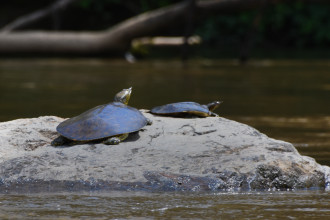Western North Carolina may be blessed with elevation and the shade of widespread forests, but the dog days of summer still drive residents and tourists alike into the cooling embrace of water. As these seekers of heat relief prepare to slip into the region’s rivers and streams, however, one question weighs on their minds above all others, according to French Broad Riverkeeper Hartwell Carson: Is it clean?
On May 25, Carson and his colleagues at local conservation nonprofit MountainTrue released a report that addresses the cleanliness query for 62 area waterways. State of the French Broad River Watershed 2018 (avl.mx/57d) summarizes a bevy of data from the N.C. Department of Environmental Quality, the Black Mountain-based Environmental Quality Institute and MountainTrue’s own monitoring to help people easily understand just how clean — or not — these waterways really are.
“Before, a lot of this data was just kind of buried in spreadsheets and wonky reports that the general public is not going to read very easily,” Carson says. “Nobody has ever combined all of that data to try and get as complete of a picture as we can about the state of the river.”
Over the map
That state, the report says, varies widely between different parts of the watershed. Waterways such as the Middle Fork of the French Broad River, Cathy’s Creek and Cataloochee Creek, which are largely fed by water from protected public lands, received A and B scores, indicating low pollution levels and healthy aquatic life. Those receiving C and D scores, indicating greater concern about pollution and wildlife, get runoff from areas with more intensive agriculture and development.
The report’s macrolevel findings didn’t surprise Carson, but he says that its results on the relative impact of different activities on water cleanliness were unexpected. “The streams that were more heavily agricultural were dirtier than we thought they would be, and the streams that were more heavily urban were a little cleaner than I thought they would be,” he explains.
While the dirtiest streams — including Turkey Creek, Newfound Creek and Fines Creek — generally lacked a single major polluter to which problems could be attributed, Carson explains that many smaller issues can chip away at water quality. “We’ve paddled several of them, and there’s indicators of a lot of streambank erosion, of cows getting into the creek and runoff from areas where livestock go to the restroom,” he says.
Carson has a more specific interpretation for the poor quality of Boylston Creek. He notes that the DEQ moved in 2008 to classify the waterway as a trout stream, which would’ve established a 25-foot buffer requirement for property along the water’s edge. Following sustained pushback from local landowners, however, the General Assembly passed a law in 2011 that specifically prevented the enhanced protection from being put in place.
“At the time, we said it was important to reclassify it because there were trout living in there and we wanted to protect them,” Carson says. “I daresay there’s probably not trout in there now because it didn’t get that protection, and it appears that the water quality has continued to decline.”
Slippery numbers?
Although all of the waterways in the report are scored on the same zero-to-100 scale, the data behind that simple metric required considerable finessing. EQI’s ratings for chemicals and stream invertebrate presence, for example, were translated from verbal descriptions such as “excellent” and “below average” into numerical ratings. Years of E. coli information from MountainTrue’s Swim Guide were turned into a single number representing the percentage of times a waterway passed the U.S. Environmental Protection Agency’s benchmark for safe swimming.
These different numbers were then weighted equally and combined to come up with a single holistic measurement for waterway cleanliness. “You’re comparing different types of data and trying to average them into one score — it was taking apples and oranges and making apples and apples,” Carson says. “I thought I’d sort of bang it out in an afternoon, and it took several months.”
Landon Davidson, regional supervisor for the DEQ’s Asheville Regional Office, says this approach helps citizens without a water quality background relate to complex data. “For its intended purpose, the report makes a very good effort of providing distilled information of [Division of Water Resources] data to the public for consideration,” he says. “In turn, this approach could foster interest and raise awareness of water quality issues, ultimately engaging locals to become involved in watershed protection activities.”
But Jen Ditzler, an environmental engineer with global consulting firm Arcadis and co-owner of Asheville-based Zen Tubing, questions whether the report accurately represents conditions on the water. She points out that MountainTrue depends on contributions from citizens concerned about water quality, a potential conflict of interest that could bias its data interpretation. “If the French Broad River is ever stated to be ‘clean,’ then MountainTrue could potentially lose out on donations and funding,” she explains.
“When you come up with your own method for looking at data, it can be skewed one way or the other depending on how you ‘feel’ about the data,” Ditzler continues. “The report would be easier to take seriously if ‘real’ data, i.e., actual numbers that were produced by an accredited laboratory, were used, versus someone’s guess as to what ‘excellent,’ “good’ or ‘poor’ mean with the random information that is available.”
Carson responds that the report’s methodology is available on the MountainTrue website. Additionally, he notes that the organization didn’t originally post its raw data because its goal was specifically to simplify very complicated information; the spreadsheet on which the report is based is now available online (avl.mx/57h).
“I would like nothing better than for the French Broad to be clean and for the many nonprofits and government entities charged with protecting it to not be needed,” Carson says. “We work hard hoping for that but also feel it is our responsibility to inform the public when the river isn’t as clean as we like, as well as promoting its use for recreation.”
Better than before

Ditzler emphasizes that she doesn’t believe area waterways to be in pristine shape, nor does she think efforts to improve their quality are in vain. “We just wish that the river would be celebrated more for how far it has come from the 1970s, when my husband paddled the river with his father,” she says.
“There seem to be two types of people: the ones that will not step foot into the French Broad River (or any other body of water) because they have ‘heard’ something bad about it and the ones that can be educated about the river (and other bodies of water),” Ditzler adds.
Sandy Melton, co-owner of Blue Heron Whitewater in Marshall, agrees that the region’s water has gotten significantly better since she started working as a raft guide in the early 1980s. “Section 9 [of the French Broad, the whitewater stretch in Madison County] was pretty bad,” she recalls. “There were foam piles a foot high in the pool below Frank Bell’s Rapid of unidentified origin or content.”
Now, notes Ditzler, endangered mussels are returning to the French Broad after years of absence, and species such as river otters, bald eagles and ospreys are regularly spotted along the banks of waterways throughout the region. And the human animal is returning to enjoy the water in ever-greater numbers.
“In the last 35 years, as water quality improved, the experience for paddlers improved,” says Melton. “Good stewardship is good for our community — and good for business!”






Before you comment
The comments section is here to provide a platform for civil dialogue on the issues we face together as a local community. Xpress is committed to offering this platform for all voices, but when the tone of the discussion gets nasty or strays off topic, we believe many people choose not to participate. Xpress editors are determined to moderate comments to ensure a constructive interchange is maintained. All comments judged not to be in keeping with the spirit of civil discourse will be removed and repeat violators will be banned. See here for our terms of service. Thank you for being part of this effort to promote respectful discussion.